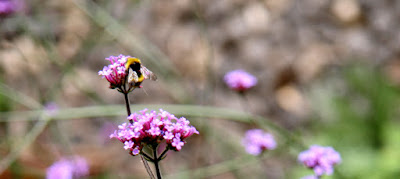 |
| Circium rivulare |
 |
| Cosmos |
An abundance of the best sustenance will come from our herbaceous plants. At the top is a bee is enjoying Circium rivulare which has a tufty thistle like flower making it easy for the bee to land on and access.
Salvias and candle plants do their best to waft about and catch the attention of hungry creatures making them also good targets for bees in summer. Plants on long stems like Verbena bodnariensis above also wave about attracting the bees attention.
Lots of shrubs are known for being particularly good for bees and most are out now. There is a hebe above. Budldleia are conveniently feeding stations as they are late summer flowers. Another popular stop again for both bees and butterfly's is the large sedums they must be particularly easy to land on and feed from. Small alpine sedium are known to produce excellent nectar in the summer and this is why we are being encouraged to grow sedum walls. Sedum Wall
Most of our Mediteranian herbs are found humming with bees as they are highly desirable easy to locate aromatic bee plants.
Late summer gardens are a buzz with bumble bees and we hear many folk exclaiming there is no problem with extinction in their garden. Alas, they are wrong. Whilst we may have an abundance of activity on our Lavenders, Penstemons, Heleniums, Verbenas and Anemones now, have we provided nourishment for Queen bees in early spring and the growing colony in late spring and early summer? The answer is usually no.
Autumn is fast approaching and it is now time to start thinking about planting ahead.The autumn is a great time to plant because it allows strong roots to establish while the plant is dormant and not straining to grow leaf. Plan your garden for next year. Bumble bees have a life cycle, where only the queen survives the winter. They are often confused with domestic Honey bees, where theoretically the whole hive consisting of thousands survive the winter. Both are having problems. Both require pollen and nectar (sugar) rich plants. Supporting Bees In Spring
The simple way to support bees is to plant plenty of nectar and pollen rich herbaceous plants and shrubs in your garden, flowering from early spring right through to late summer.
 |
| Bees munching on verbena bodnariensis |
This summer I wonder if there are more bees about, buzzing round our herbaceous. This is knautia in the scabious family.
The real winners will be the echinaceas and those with similar great cones for landing pads.
Echinops with their sivery blue balls of flower have are equally good pad to land on.
 |
| Knautia |
The real winners will be the echinaceas and those with similar great cones for landing pads.
 |
| Echinacea |
 |
| Salvia |
 |
| Hebe |
 |
| Caryopteris |
Late summer gardens are a buzz with bumble bees and we hear many folk exclaiming there is no problem with extinction in their garden. Alas, they are wrong. Whilst we may have an abundance of activity on our Lavenders, Penstemons, Heleniums, Verbenas and Anemones now, have we provided nourishment for Queen bees in early spring and the growing colony in late spring and early summer? The answer is usually no.
Autumn is fast approaching and it is now time to start thinking about planting ahead.The autumn is a great time to plant because it allows strong roots to establish while the plant is dormant and not straining to grow leaf. Plan your garden for next year. Bumble bees have a life cycle, where only the queen survives the winter. They are often confused with domestic Honey bees, where theoretically the whole hive consisting of thousands survive the winter. Both are having problems. Both require pollen and nectar (sugar) rich plants. Supporting Bees In Spring
The simple way to support bees is to plant plenty of nectar and pollen rich herbaceous plants and shrubs in your garden, flowering from early spring right through to late summer.



